Chapter 3:
American Federalism
Summary
A federal system is one in which the Constitution divides powers between the central government and subdivisional governments. Federal systems check the growth of tyranny, allow unity without uniformity, encourage state experimentation, permit power sharing between the national government and the states, and keep government closer to the people. Alternatives to federalism are unitary systems and confederations.
The national government has the constitutional authority (according to the national supremacy clause), the war powers, and the powers to regulate commerce among the states to tax and spend, and to do what Congress thinks is necessary and proper to promote the general welfare and to provide for the common defense.
States must give full faith and credit to each other's public acts, records, and judicial proceedings. They must also give to each others' citizens the privileges and immunities they give their own. Fugitives must be returned from justice to states that claim them.
The federal courts settle disputes on the division of power between the national and state governments. In landmark Supreme Court cases, such as Gibbons v. Ogden and McCulloch v. Maryland, the power of the national government over the states was asserted and a national economic common market was promoted.
The major instruments of federal intervention in state programs have been various kinds of financial grant-in-aid, of which the most prominent are categorical-formula grants, project grants, and block grants. The national government also imposes federal mandates and controls activities of state and local governments by other means.
Key Terms
1. Devolution Revolution: The effort to slow the growth of the federal government by returning many functions to the states. The Devolution Revolution weakens the federal government and empowers the states. To the right is a political cartoon concerning "devolution revolution." Interesting article "Devolution Revolution: Why Congress is Shifting a Lot of Power to the Wrong Levels." | 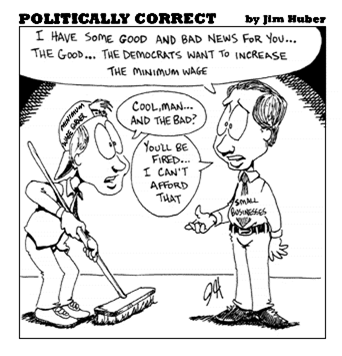 |
 | 2. Federalism: Form of government in which Constitutional arrangement distributes power between a central government and subdivisional governments where both governments exercise direct authority over individuals. In Federalism, a central government and subdivisional governments are given responsibilities based on the Constitution. To the left is a visual concerning "federalism." Click for more in-depth details on "federalism." |
3. Dual Federalism (Layer Cake Federation): Federalism that views the Constitution as giving a limited list of powers (primarily foreign policy and national defense) to the national government, leaving the rest to sovereign states. The Supreme Court settles disputes over which level of government has responsibility for an activity. During the United States' first hundred years, the Supreme Court favored the interpretation of dual federalism. To the right is a diagram that explains "dual federalism." |  |
 | 4. Cooperative Federalism: Federalism that stresses a system of intergovernmental relations in delivering governmental goods and services to the people and calls for cooperation among various levels of government. The levels of government must cooperate with each other in order for cooperative federalism to be successful. To the right is a political cartoon portraying "Cooperative Federalism." |
5. Marble Cake Federalism: Federalism is like a marble cake in which all levels of government are involved in a variety of issues and programs, rather than a layer cake (dual federalism) with fixed divisions between layers or levels of government. The divisions between levels of government are not fixed in marble cake federalism. To the right is a visual representation of "Marble Cake Federalism." |
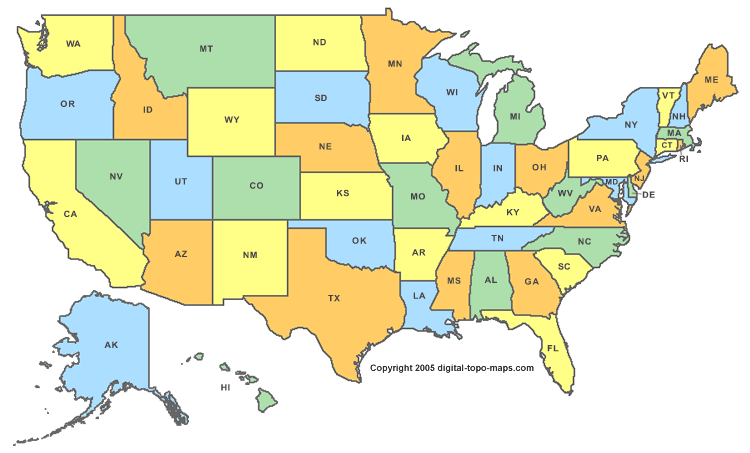 | 6. Competitive Federalism: The national government, fifty states, and thousands of local governments compete with each other over ways to put together packages of services and taxes. In competitive federalism, all levels of government compete with each other to impose services and taxes. To the left is a picture of all fifty states. The states compete with each other and with the national government. |
7. Permissive Federalism: Although federalism provides "a sharing of power and authority between the national and state government, the states' share rests upon the permission and permissiveness of the national government." The national and state government "share" power in permissive federalism, but the state government still relies on how permissive the national government is. To the left is an image of the American flag to show that the national government is essentially the one in control, because the states rely on its permissiveness. |  |
 | 8. "Our Federalism": The power of the federal government is limited in favor of the broad powers reserved to the states. In "Our federalism," the states have broad powers, limiting the power of the national government. To the left is a picture of former President Ronald Reagan, who coined the term "Our Federalism." |
9. Creative Federalism: The federal government determines the needs of the states. During the time that Creative Federalism was popular (Johnson's administration1963-1969), the federal
government worked extensively with the states to provide social
services. To the right is a picture of former President Lyndon B. Johnson. It was during his administration that creative federalism was the most popular. | 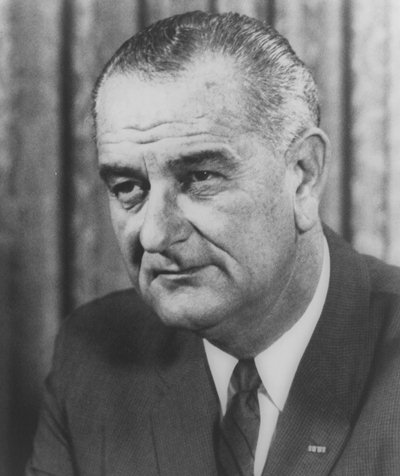 |
 | 10. Fiscal Federalism: The national and state government share revenues from tax. Fiscal federalism allows the revenues to be raised by either the national or state government and switched between them. To the left is a picture showing that tax can be increased or decreased.
|
11.Unitary System: Constitutional arrangement in which power is concentrated in a central government. A unitary system, where all governmental power is vested in the national government, is an alternative to federalism. To the right is a diagram of a "unitary system." For more details on a "unitary system," see "What is a Unitary System?" | 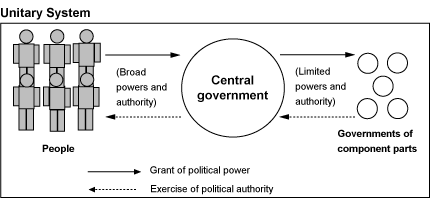 |
 | 12. Confederation: Constitutional arrangement in which sovereign nations or states, by compact, create a central government but carefully limit its power and do not give it direct authority over individuals. In a confederation, the central government creates the rules and regulations only with the state governments directing it. To the left is a picture that shows the powers of the Articles of Confederation. Click for more information on basic policies of a "confederation." |
13. Express Powers / Enumerated Powers / Delegated Powers: Powers specifically granted to one of the branches of the national government by the constitution. The power to regulate interstate commerce and the power to appropriate funds are examples of express powers. To the right is a picture of gold and coined money, because the power to appropriate funds is an example of an "enumerated power." Click to read a list of "enumerated powers" with details.
|  |
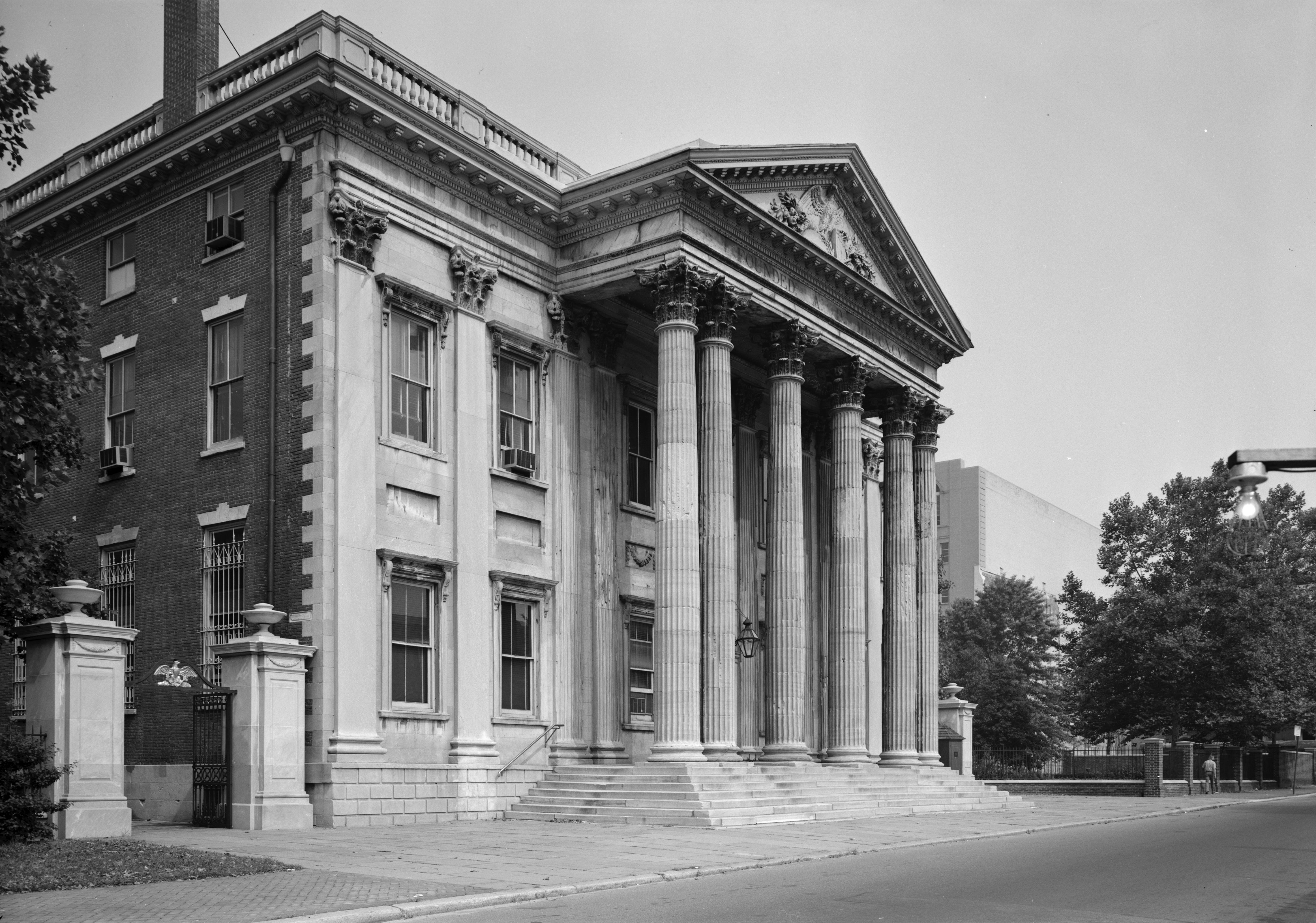 | 14. Implied Powers: Powers inferred from the express powers that allow Congress to carry out its functions. The power to create banks is an implied power of Congress. It does not state directly in the Constitution that Congress has the power to create banks, but the necessary and proper clause allows Congress to do what is best for the nation. To the left is a picture of a bank created by the implied power of Congress. Click for more information on "implied powers." |
 | 15. Reserved Powers: The reserved powers of the states are the powers which the Constitution neither delegates to the national government nor denies the states. Reserved powers are reserved to the states, or the people, by the Constitution.
|
16. “Necessary and Proper” Clause (Article I, Section 8, Clause 18): It states that Congress, in addition to its express powers, has the right to make all laws necessary and proper for carrying out all powers vested by the Constitution in the national government. Although a power may not be stated in the Constitution, Congress still has the right to make an essential law thanks to the necessary and proper clause. To the right is a political cartoon that shows the "necessary and proper clause." Click for more details on the "necessary and proper clause."
|  |
 | 17. Inherent Powers: The powers of the national government in the field of foreign affairs that the Supreme Court has declared do not depend on constitutional grants but rather grow out of the very existence of the national government. The federal government can deal with other nations with some authority as though it were a central government in a unitary system.
Inherent powers allow the nation to To the left is a picture of soldiers, showing how the U.S. Click for more information on "inherent powers." |
18. Supremacy Clause (Article VI): States that "this Constitution, and the Laws of the United States...and all Treaties made...under the Authority of the United States, shall be the supreme Law of the Land..." All officials, in both state and national fields, swear an oath to support the Constitution of the United States, the supreme law of the land, which is stated in the supremacy clause. To the right is a political cartoon of Gibbons v. Ogden, the case where the supremacy clause was established. | 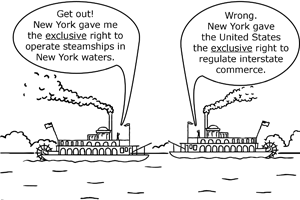 |
19. Preempt: Have precedence over National laws and regulations of federal agencies preempt the field, causing conflicting state and local regulations the inability to be enforced. To understand this word better, please read "Facts About Federal Preemption," which includes an example of federal preemption on immigration laws. |
20.Commerce Clause (Article I, Section 8, Clause 3): The clause in the Constitution that gives Congress the power to regulate all business activities that cross state lines or affect more than one state or other nations. Through the commerce clause, the national government has found constitutional jurisdiction for regulating a wide range of human activity. To the right is a cartoon about the "commerce clause." Click to see more information on the "commerce clause." | 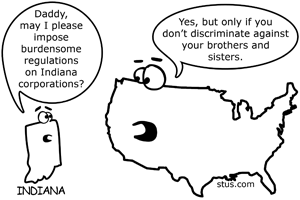 |
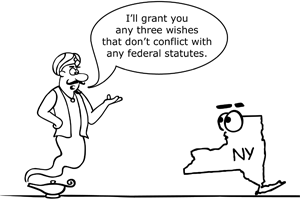 | 21. Gibbons v. Ogden: A dispute over a monopoly to operate steamboats in New York waters that the state of New York had granted to Robert Livingston and Robert Fulton. Ogden, who was licensed to have the exclusive right to operate steamboats between NY and NJ, sued to stop Thomas Gibbons from running a competing ferry. The ruling promoted a national economic common market in holding that states may not discriminate against interstate transportation and out-of-state commerce. In Gibbons v. Ogden, interstate commerce was defined as "intercourse that affects more states than one," allowing national interests to prevail. To the left is a political cartoon of Gibbons v. Ogden. |
 | 22.Federal mandate: A requirement imposed by the federal government as a condition for the receipt of federal funds. Congress requires states to do certain things, called federal mandate, but often does not supply the funds necessary to carry out what have come to be known as "unfunded mandates." Click for more details about "federal mandates." |
23. Concurrent Powers: Powers that the Constitution gives to both the national and state government, such as the power to levy taxes. The Constitution allows the national and state government to both have concurrent powers. To the right is a diagram of "concurrent powers." | 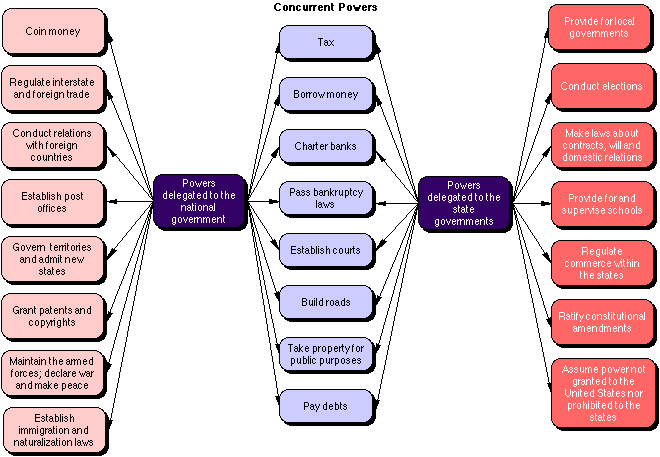 |
 | 24. Full Faith and Credit Clause (Article
IV, Section 1): Clause in the Constitution requiring each state to recognize the
civil judgments rendered by the courts of the other states and to accept their
public records and acts as valid. The full faith and credit clause applies mostly to enforcing judicial settlements and court awards. Click to read a simplified version of the "full faith and credit clause". |
25. Privileges and Immunities Clause: States must extend to citizens of other states the privileges and immunities they grant to their own citizens, including the protection of the laws, the right to engage in peaceful occupations, access to the courts, and freedom from discriminatory taxes. The privileges and immunities clause allows citizens to be treated the same lawfully in a state different from their own. To the right is a cartoon displaying the "privileges and immunities clause." |  |
26. Extradition: Legal process whereby an alleged criminal offender is surrendered by the officials of one state to officials of the state in which the crime is alleged to have been committed. An alleged criminal offender must be returned by extradition to the state where the crime was committed when he/she has fled to another state. To the right is a picture of law enforcement officials involved in "extradition." Click for more information concerning details of "extradition."
|  |
 | 27. Interstate Compact: An agreement among two or more states. The Constitution requires that most such agreements be approved by Congress. States settle disputes without force using an interstate compact.
To the right is a cartoon displaying the |
28. McCulloch v. Maryland: Supreme court case which defined the division of power between the national and state governments. Congress had established the Bank of the United States, but Maryland opposed any national bank and levied a $10,000 tax on any bank not incorporated within the state. James William McCulloch, a cashier of the bank, refused to pay on the grounds that a state could not tax an instrument of the national government. The Court ruled in favor of McCulloch. National supremacy was established in the court case, McCulloch v. Maryland. To the right is a political cartoon of the court case. Click for more information on "McCulloch v. Maryland." | 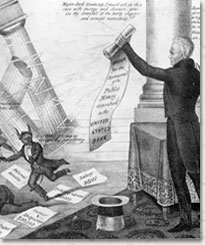 |
29.National Supremacy: Constitutional doctrine that whenever conflict occurs between the constitutionally authorized actions of the national government and those of a state or local government, the actions of the federal government prevail.
National supremacy was established in
Click to read more about "national supremacy." |  |
 | 30.Preemption: The right of a federal law or regulation to preclude enforcement of a state or local law or regulation. A federal law or regulation takes precedence over a state or local law due to preemption. Click to read examples of "preemption." |
 | 31.Centralists: People who favor national action over action at the state and local levels. Centralists favor the national government. Click to read more about "Centralists versus Decentralists"
32.Decentralists: People who favor state or local action rather than national action. Decentralists favor the state governments. Click to read more about "Centralists versus |
33. States’ rights: Powers expressly or implicitly reserved to the states and emphasized by decentralists. Decentralists supported the states' rights. Click to read more about "states' rights"
| 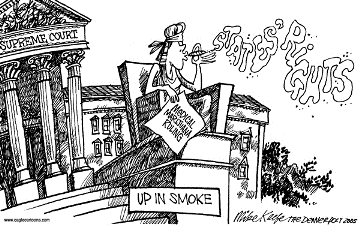 |
 | 34. Tenth Amendment: The Tenth Amendment reserves powers for the states. It states: "The powers not delegated to the United States by the Constitution, nor prohibited by it to the States, are reserved to the States respectively, or to the people." Centralists and decentralists argue over states' rights, an important concept of the Tenth Amendment. Click to read more about the "tenth amendment" |
35. Categorical-formula Grants / Categorical Grants: Congress appropriates funds for specific purposes, which are allocated by formula and are subject to detailed federal conditions. Categorical grants provide federal supervision to ensure that the federal dollars are spent as Congress wants. Medicaid is an example of a categorical grant program. Click here to read more about Federalism and "categorical-formula grants / categorical grants" |  |
 | 36. Project Grants: Congress appropriates a certain sum, which is allocated to state and local units and sometimes to nongovernmental agencies, based on applications from those who wish to participate. Grants by the National Science Foundation to universities and research institutes to support the work of scientists or grants to states and localities to support training and employment programs are examples of project grants. The picture to the left is the symbol of the National Science Foundation, which is an organization that funds project grants. |
37. Block Grants: These are broad grants to states for prescribed activities (welfare, education, child care, social services, preventive health care, and health services) with only a few strings attached. States have flexibility in deciding how to spend block grant dollars, but there are no more matching federal dollars when the federal funds for any fiscal year are gone. Click here to read more about "block grants." |
38. Unfunded Mandates: Imposed mandates that did not provide federal funds to accomplish the mandates. Fewer federal dollars does not mean fewer federal controls as seen in the issuing of unfunded mandates. Click to read about examples of "unfunded mandates" |
39. Americans with Disabilities Act (1990): Called on state and local governments to build ramps and alter curbs, renovations that cost millions of dollars, to make public buildings accessible to the blind and persons in wheelchairs or on crutches. The Americans with Disabilities Act is an example of an unfunded mandate by the federal government. To the right is an icon for the Americans with Disabilities Act. Click here to read more about the "Americans with Disabilities Act" |  |
 | 40. Direct Orders: A technique of Congress to establish federal regulations. Direct orders must be complied with under threat of criminal or civil sanction. The Equal Employment Opportunity Act of 1972, which barred job discrimination by state and local governments on the basis of race, color, religion, sex, and national origin, is an example of a direct order. To the left is an icon for the Equal Employment Opportunity Act. Click here to read an article about "direct orders" |
41. Cross-cutting Requirements: A technique of Congress to establish federal regulations. . Federal grants may establish certain conditions that extend to all activities supported by federal funds, regardless of their source. The 1964 Civil Rights Act, which holds that in the use of federal funds, no person may be discriminated against on the basis of race, color, or national origin, is an example of a cross-cutting requirement. To the right is a photo showing the Civil Rights Act of 1964. Click here to read more about "cross-cutting requirements" | 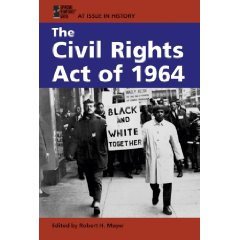 |
42. Total and Partial Preemption: Techniques of Congress to establish federal regulations. Total preemption rests on the national government's power under the supremacy and commerce clauses to preempt conflicting state and local activities. Partial preemption establishes basic policies but requires states to administer them. Total and partial preemption are a power of the national government to establish policies and activities of the states. Click here to read an article called "Federal Preemption of Actions Related to Airport Noise" |
43. Crossover Sanctions: Sanctions that permit the use of federal money in one program to influence state and local policy in another.
An example of a crossover sanction is a 1984 act that reduced federal highway aid by up to 15% for any state that failed to adopt a minimum drinking age of 21.
Click here to read a brief article involving a "crossover sanction."
Fill in the Blank
1. What
is the clause in the Constitution requiring each state to recognize the civil
judgments rendered by the courts of the other states and to accept their public
records and acts as valid? ________________
2. Powers
inferred from the express powers that allow Congress to carry out its functions
are called ________________.
3. What
clause states that Congress, is addition to its express powers, has the right
to make all laws necessary and proper for carrying out all powers vested by the
Constitution in the national government?_______________
4. The
effort to slow the growth of the federal government by returning many functions
to the states is called __________________.
5. The
powers of the national government in the field of foreign affairs that the
Supreme Court has declared do not depend on constitutional grants but rather
grow out of the very existence of the national government are called
___________________.
6. What
do you call the powers expressly or implicitly reserved to the states and
emphasized by decentralists? ___________________
7. ______________
are people who favor national action over action at the state and local levels.
8. The
_________________ is a constitutional doctrine that whenever conflict occurs
between the constitutionally authorized actions of the national government and
those of a state or local government, the actions of the federal government
prevails.
10. ___________________
is a Constitutional arrangement whereby power is distributed between a central
government and subdivisional governments both exercise direct authority over
individuals.
11. ___________________
are Powers that the Constitution gives to both the national and state
government, such as the power to levy taxes.
13. ___________________
are powers specifically granted to one of the branches of the national
government by the constitution.
14. The
________________ is a clause in the Constitution that gives Congress the power
to regulate all business activities that cross state lines or affect more than
one state or other nation.
15. A
requirement imposed by the federal government as a condition for the receipt of
federal funds is called_________________.
16. ___________________is
a legal process whereby an alleged criminal offender is surrendered by the
officials of one state to officials of the state in which the crime is alleged
to have been committed.
17. ___________________is
an agreement among two or more states. The Constitution requires that most such
agreements be approved by Congress.
18. The
right of a federal law or regulation to preclude enforcement of a state or
local law or regulation is called _________________.
19. __________________
are people who favor state or local action rather than national action.
Questions! (Multiple Choice, True/False, Short Answer)
a. dual federalism
b. cooperative federalism
c. marble cake federalism
d. competitive federalism
e. permissive federalism
2) This Supreme Court case's ruling promoted a national economic common market in holding that states may not discriminate against interstate transportation and out-of-state commerce.
a. Gibbons v. Ogden
b. McCulloch v. Maryland
c. Brown v. Board of Education
d. Marbury v. Madison
e. Buckley v. Valeo
3) Which amendment reserves powers for the states?
a. Amendment I
b. Amendment XX
c. Amendment XII
d. Amendment X
e. Amendment VI
4) What is the Americans with Disabilities Act an example of?
a. extradition
b. fiscal federalism
c. block grant
d. unfunded mandate
e. crossover sanction
5) What clause states that "this Constitution, and the Laws of the United States...and all Treaties made...under the Authority of the United States, shall be the supreme Law of the Land..."?
a. elastic clause
b. law of the land clause
c. supremacy clause
d. commerce clause
e. authority clause
6) What are the sanctions that permit the use of federal money in one program to influence state and local policy in another called?
7) True/False: A federal system is one in which the Constitution divides powers between the central government and subdivisional governments.
8) When must direct orders be complied with?
9) Name two of the major instruments of federal intervention in state programs that have been various kinds of financial grant-in-aid?
10) What are broad grants to states for prescribed activities (welfare, education, child care, social services, preventive health care, and health services) with only a few strings attached called?
a. project grants
b. block grants
c. direct orders
d. cross-cutting requirements
e. crossover sanctions
11) What clause states that states must extend to citizens of other states the privileges and immunities they grant to their own citizens, including the protection of the laws, the right to engage in peaceful occupations, access to the courts, and freedom from discriminatory taxes?
12) True/False: Partial preemption rests on the national government's power under the supremacy and commerce clauses to preempt conflicting state and local activities. Total preemption establishes basic policies but requires states to administer them.
13) What Supreme Court case determined that Congress had the power to incorporate the national bank and that Maryland could not tax instruments of the national government employed in the execution of constitutional powers?
14) What type of federalism holds that the national and state government share revenues from tax?
a. fiscal federalism
b. creative federalism
c. dual federalism
d. "our federalism"
e. permissive federalism
15) What type of federalism holds that the power of the federal government is limited in favor of the broad powers reserved to the states?
a. fiscal federalism
b. creative federalism
c. dual federalism
d. "our federalism"
e. permissive federalism
16) True/False: An alleged criminal offender must be returned by extradition to the state where the crime was committed when he/she has fled to another state.
Answers:
1) b
2) a
3) d
4) d
5) c
6) crossover sanctions
7) True
8) under threat of criminal or civil sanction
9) categorical-formula grants, project grants, block grants
10) b
11) privileges and immunities clause
12) False
13) McCulloch v. Maryland
14) a
15) d
16) True